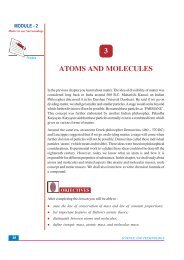NIOS : The Way Forward - The National Institute of Open Schooling
NIOS : The Way Forward - The National Institute of Open Schooling
NIOS : The Way Forward - The National Institute of Open Schooling
Create successful ePaper yourself
Turn your PDF publications into a flip-book with our unique Google optimized e-Paper software.
56 / <strong>NIOS</strong>: <strong>The</strong> <strong>Way</strong> <strong>Forward</strong><br />
6.12 Harnessing ICTs in <strong>Open</strong> and Distance Learning Environment<br />
ICT represents a set <strong>of</strong> technological tools used to create, store, communicate,<br />
and manage information. <strong>The</strong>se technological tools include computers,<br />
telephone, internet, and broadcasting technologies (radio and television).<br />
<strong>The</strong>se tools help us in several information related activities (such as access,<br />
retrieve, store, organize, modify, produce, present and exchange information<br />
by electronic and other automated means). <strong>The</strong> ICT is highly dynamic in nature.<br />
Day by day new and innovative technologies are coming up which can be<br />
used in the field <strong>of</strong> educational management particularly in imparting quality<br />
education. Some <strong>of</strong> the emerging trends in ICT which are required for<br />
educational institutions like <strong>NIOS</strong>, for capacity building and for improving<br />
educational programmes are mentioned below.<br />
<strong>The</strong> following are the thrust areas for ODL/ICT interface:<br />
• With ICT inputs, develop Self-paced learning packages that enable learners<br />
to work individually on the basis <strong>of</strong> print material supplemented by audio<br />
and video cassettes, CDs, DVDs etc.<br />
• Mixed–mode study (Blended Learning) that allows self-study to be<br />
supplemented with group-work, workshops, tutorials and other structured<br />
activities.<br />
• On-line study that allows the learner to use on-line resources on computer,<br />
via internet. This may be in self-study mode and interaction with peers<br />
and teachers through chat, e-mail, web-cam, voice-mail, etc.<br />
• Video conferencing at a convenient location for close interaction with the<br />
teacher without having to travel long distances.<br />
• Audio conferencing which use telephone to communicate with teachers,<br />
tutors, and peers.<br />
6.12.1 Web-based On-line Education<br />
Thousands <strong>of</strong> courses are today available on-line from various universities<br />
and commercial training institutions. <strong>The</strong>se span a wide range <strong>of</strong> topics for<br />
fundamental subjects at school level to skill-based subjects such as network<br />
administration and programming language. Many institutions <strong>of</strong>fering traditional<br />
distance learning programmes are also beginning to exploit the Internet and<br />
world wide web (www) for reaching out to a wide range <strong>of</strong> learners. Online<br />
distance education is redefining the way people study. Not only can a learner<br />
study at his/her own pace, he/she can also interact with hundreds <strong>of</strong> students<br />
across the world. <strong>NIOS</strong> needs to create appropriate strategy for <strong>of</strong>fering the<br />
courses through its web-based portal.

















